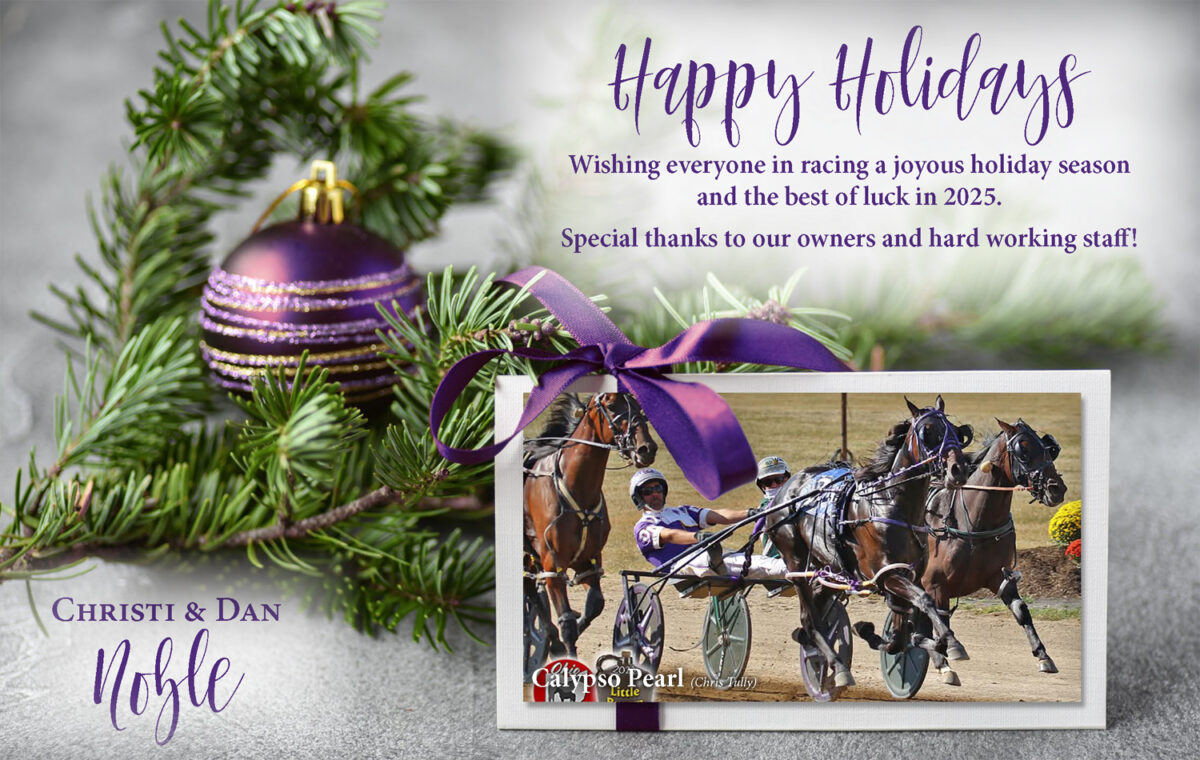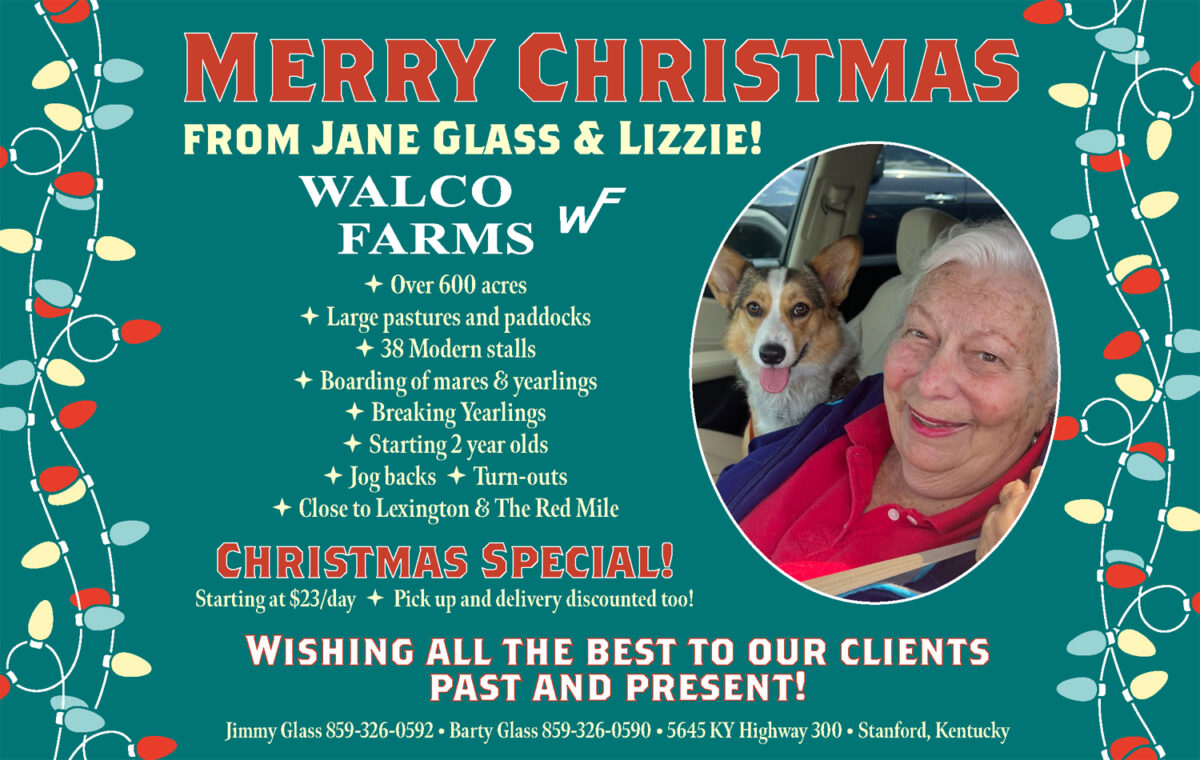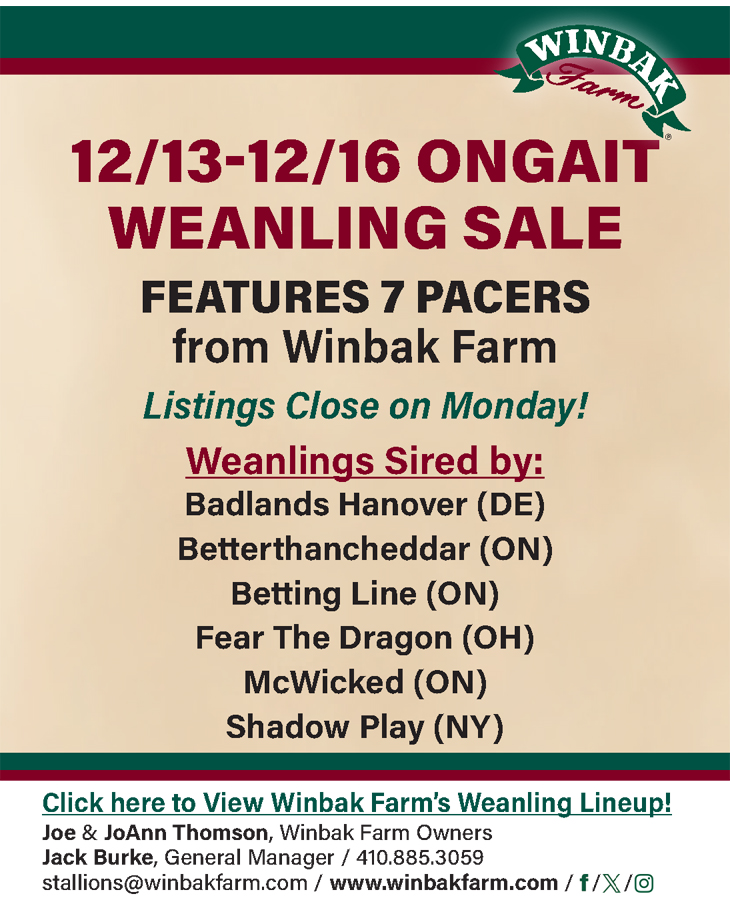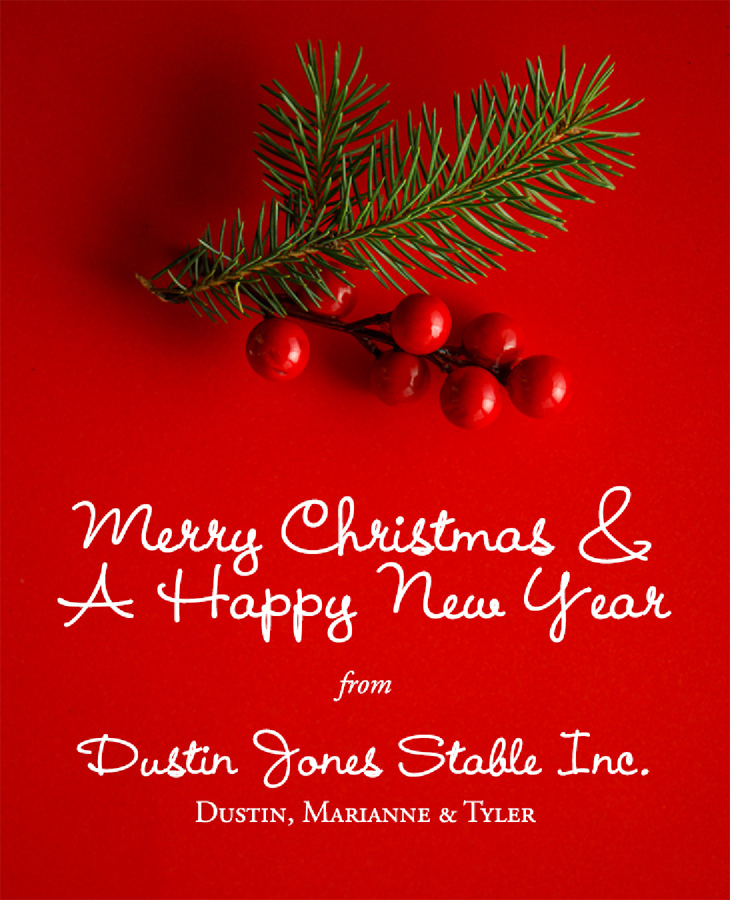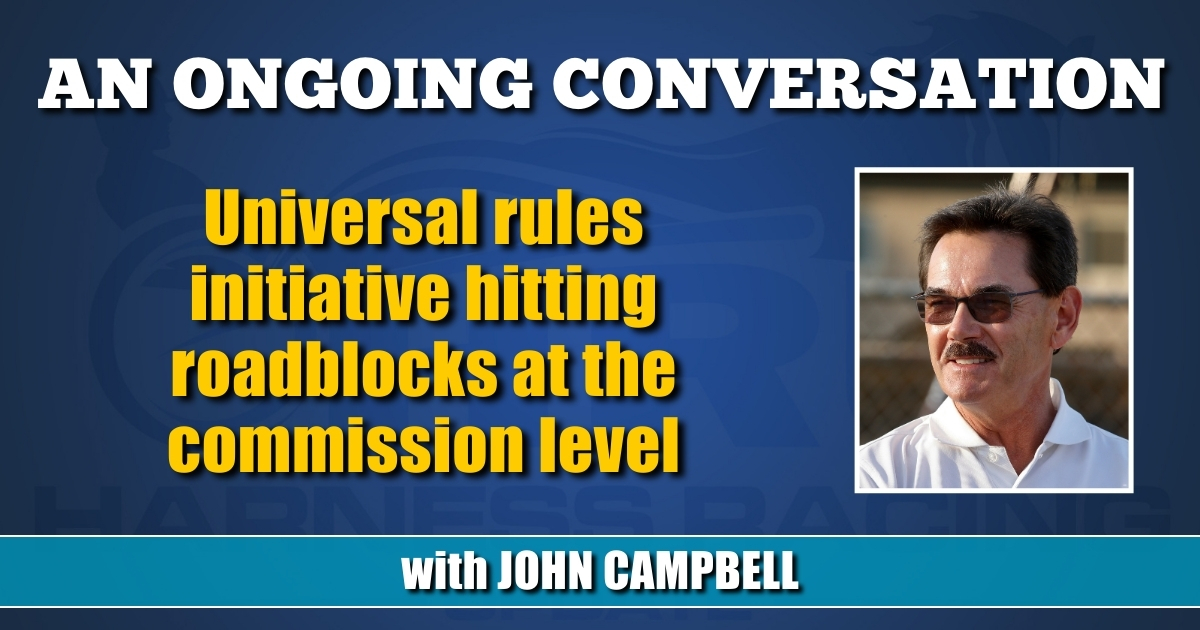

Universal rules initiative hitting roadblocks at the commission level
by Dave Briggs
Editor’s Note: This is the first in an ongoing, semi-regular conversation with Hall of Famer and Hambletonian Society president and CEO John Campbell. We are providing this forum for Campbell to publicly discuss industry issues important to him. We will also use this as an opportunity to travel down memory lane and talk about the people and horses that had a major impact on his life.
Few industry issues are as important — and vexing — to John Campbell as his multi-year quest to establish universal rules for the sport across North America.
Shortly after retiring from driving midway through 2017 to take the helm of the Hambletonian Society, Campbell began working diligently on the project.
“I put a committee together… and it was a cross-section of racetrack operators, drivers, judges, race commission executive director… we reviewed the rules and changed some and added some, but a lot of it was just rewording and trying to make the rules more definitive and, in essence, easier for the judges to make calls,” he said.
“We did that (in the U.S.), then (Standardbred Canada CEO) Dan Gall also formed a committee in Canada at the same time. It was kind of a parallel committee and it was made up of mostly regulators in Canada, which was easier to do because there are fewer provinces that have harness racing. They were the dominant voice on the Canadian committee.”
Campbell said a set of proposed rule changes were then presented to the United States Trotting Association (USTA) in 2018 and 2019.
“I have to say that the USTA was very receptive,” Campbell said. “They went through two committees and the full board. They were certainly well-vetted and there were instances where we changed wording that came up that we had overlooked, so that was fine.
“From there, (USTA CEO) Mike Tanner and I presented these rules to ARCI, the Association of Racing Commissions International, and they were vetted by their rules committee. All but one of them, that pertained to prescription drugs and breathalyzer for humans — and there was a legal issue on that – but every other one that we proposed passed. So, now they are sitting in the offices of ARCI.”
Campbell said the frustrating part is some racing commissions won’t even look at the proposed rule changes.
“I don’t want to put all of the commissions under the same roof or label, because some are certainly better than others. Some have looked at them, but sitting in the offices of Standardbred Canada and ARCI is the potential for very similar racing rules throughout North America.”
While once there was hope that Canada was close to adopting nation-wide universal rules, Gall said the initiative has stalled for a couple of reasons — getting Quebec to agree and the fact racing commissions are more focused on how to race safety during a pandemic.
‘With government the last thing on their plate is regulation for rules (of racing). They are more worried about rules for COVID-19,” Gall said.
“But, the biggest problem we’ve got is Quebec and not just the language barrier. We’ve had them at the table all the way around, we’ve provided them with translators because it was tough sledding to do it because of the language barrier. They were with us all the way through the review, but then when it came to saying, ‘Okay, guys, what’s the next step, how do you implement?’ They told us they have to go to the legislature and get government to approve the changes.”
That hurdle is particularly high during a pandemic.
Yet, overall, racing commissions across Canada have been receptive to establishing universal rules, Gall said.
“I’m really pleased with how well the industry and the commissions responded. The other follow-up call to them is ‘Guys, if there was a change of anything that we’ve done, that we’ve talked about, that, for whatever reason, you’re not going to do or you’re going to change it, what’s the process so that we’re all holding hands, because the idea here is not so that we do this exercise and then everybody goes rogue for three to five years.
“What kind of communication can we establish that we have a touch point, whether it’s quarterly, bi-annually or annually, so that we can go, ‘Is there anything that’s changed or that you guys are looking at that we should all be looking at, and/or are there any other new rules that we should all be considering to be consistent with?’”
As for Campbell, he admits he was, “a little naïve” to think universal rules would be established by now.
“I thought it would go quicker, for sure, but once I got into it, I knew how long it was going to take. But I really thought there would be more response from the commissions to at least look at them and even reach out to us for an explanation of why we did that. We did have a couple of mandates that we were going by and one, obviously, was to make the rules more concise, more definitive and easier for the judges to interpret and for the participants to understand.
“Also, many of the rules were geared to making the races less predictable and when you do that you help the closers, so we did put rules in there… we strengthened the terminology for holes in the first part of the race and also strengthened half-in, half-out and put a rule in that the lead horse could not be more than four feet off the rail going down the backstretch. So, to stop that when they all just keep drifting out. There were a number of them that were put in and some were just reworded from older rules.”
Campbell said the committee decided that the “extended run” should be changed so that a horse on a break for 25 consecutive strides would be placed last. The rule change was discussed at the model rules committee in Saratoga and Campbell said, “one executive director of a state got up and said, ‘I’m not going to vote against this, I’m in favor of this, but we’re not going to put it in in our state.’”
Campbell said there was no further explanation as to why the rule would not be adopted in that state.
“I was absolutely flabbergasted when he said that. If you look at just in HRU, you had two ‘extended run’ rules come up last year, one from Yonkers (full story here) and one from The Red Mile (full story here). In both instances, if the 25-stride rule had been in effect, it would not have even been a debate, because they were both well over 25 and once you get to 25, you’re placed last. It’s black and white. The participants know it and the bettors know it.”
Campbell said another example is the pylon rule. Campbell said Ontario’s pylon rule was essentially adopted by the USTA, “but it’s certainly not universal by any stretch. To think that 30 years later, we don’t have all the commissions on the same page in reference to pylons, it’s just wrong.”
Part of the problem, Campbell said, is that to change racing rules in many jurisdictions you have to change state laws or statutes and go through the process of public filings and public notice.
“Still, it’s not impossible, it’s just cumbersome and again it goes to the ineffectiveness and inefficiency of the whole situation,” he said.
Campbell also said a rule change is needed to allow judges to be able to call for a recall, not just the starter. The issue came to a head recently in a race at Northfield Park as described by HRU columnist Brett Sturman (full story here).
“In Ohio, it’s entirely up to the starter, whether there’s a recall or not. We had eluded in one rule change at USTA that the judges be involved in that decision, so you have three extra sets of eyes sitting high up to assist the starter in there. In many states, it’s entirely up to the starter, which personally I think is unfair, because he’s at ground level and you could have three sets of eyes up on top assisting him with that in the cases of broken equipment, interference, before the start.”
LEGEND ON A LEGEND
When discussing legends from Campbell’s past that had particular influence on his life and career, it seems appropriate to start with the patriarch of the Campbell racing family — his late grandfather Dunc Campbell, who was inducted into the Canadian Horse Racing Hall of Fame in 1983.
Campbell roots run deep on Argyle Road near Ailsa Craig, ON, west of the city of London. John’s great great grandfather settled there when he arrived from Scotland in 1832.
Dunc Campbell was born in 1900.
“He went through raising a family right through the Great Depression,” John said of his grandfather. “He told me many stories about (the Depression) that we can’t even fathom in this day and age.
“He started fooling with horses in the late-1920s. He had a neighbor a concession over that knew a little bit about it and he got interested in them. He bought a horse, so they got ready to race him and this neighbor was going to drive him and just before the race he said to my grandfather, ‘If you’re going to be in this business, you better drive it.’ At that time, you didn’t even need a license, so he drove it and won the first heat. He said, ‘They didn’t know who I was or who my horse was,’ but he said it was a lot tougher for the rest of the day. That was the only one he won.”
Not many years later, Dunc bought a couple of mares that were full sisters.
“One was called Babe Grattan and she was the foundation mare for almost every good horse that he had. He raced her five heats at Goderich one day and she won three, so that was the race. He won $1,000 and it was exactly what he owed the bank and he came back and was able to pay that $1,000 back to the bank from what he earned that day.”
John laughs when asked about an old quote that as a boy he watched his grandfather do more hard work after age 60 than most people do in their lives.
“It was incredible. Anybody that knew him or was around him or watched him… he just had that work ethic. Very little down time and no recreation time. His whole mindset was ‘If you were awake, then you were supposed to be working.’
“I didn’t get it like him, I can tell you that. My dad was a hard worker, but even he would laugh if you compared him to my grandfather.
“As hard a worker as he was, his family meant everything to him and I know that was a thread that came right through to my dad… It was the number one thing and nobody ever lost track of that for anything.”
One of John’s favorite memories is being allowed to go with his grandfather to race at Old Woodbine in Toronto, the track that later became Greenwood Raceway.
“I can vaguely remember being with my grandpa down there, just him and I in a tack room. I was 4, so he took me as a 4-year-old down there with no babysitter or anything like that. We slept in the tack room and I’d be there for four or five days at a time with him until somebody else came down to watch the races and I came home with them. I think he’d be 59 at the time, watching out for this 4-year-old toddler. I remember just having a great time, any time I was away with him,” he said.
One horse memory with Dunc stands out for John.
“We had a horse called ArgyelChester that I owned with my grandmother and he was in-to-go on a Saturday night down in Windsor and I believe it was an opening night invitational and it was a really good field back then,” John said. “Dad had something and he wasn’t going to be there, so grandpa was going down to drive him. He and I rode down together to race Chester and he ended up winning that night and it was really a big win for us. I remember coming back and it was just a few weeks before my grandmother took sick and she never really recovered. I remember him telling her that we won and it was just a great night for him, me and her.”
The night Dunc was inducted into the Canadian Horse Racing Hall of Fame, John remembers brimming with pride.
“Certainly, I was aware of what he started from and to be recognized by the Hall of Fame I was just so proud of him and I told him that, that night. It was a great experience for me.
“I’d like to have a dollar for every ride I had on the jog cart or, in the winter time, a cutter ride, with him when he was training horses or jogging horses.”






